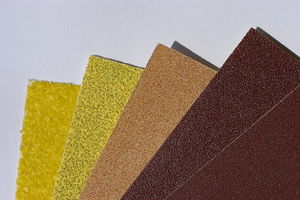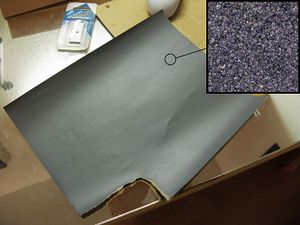Sandpaper
Sandpaper is abrasive grit fixed to paper.
Sandpaper is one type of coated abrasive. Its used to remove small amounts of material from surfaces, either
- to make them smoother (painting and wood finishing)
- to remove a layer of material (e.g. old paint)
- sometimes to make a surface rougher (e.g. as a preparation to gluing).
History
The first recorded instance of sandpaper was in 13th century China when crushed shells, seeds, and sand were bonded to parchment using natural gum.
Sandpaper was originally known as glass paper, as it used particles of glass. Glass frit has sharp-edged particles and cuts well, sand grains are smoothed down and did not work as well as glass. Cheap counterfeit sandpaper has long been passed off as true glass paper; Stalker and Parker cautioned against it as far back as the 17th century. (Stalker & Parker 1688: A Treatise of Japaning and Varnishing, 1971)
Glass paper was manufactured on a large scale in London by 1833.
In 1916, 3M invented Wetordry. This allowed use with water as a lubricant, to carry away particles that would otherwise clog the finest grades and badly impair performance. Its first application was for car paint refinishing.
Types of sandpaper
There are countless varieties of sandpaper, with variations in the paper or backing, the material used for the grit, grit size, and the bond.
Backing
In addition to paper, available backings for sandpaper include cloth (much more flexible, used on belt sanders) and cellulose fibre (more or less rigid, used for angle grinder sanding discs). Other backings are found outside of DIY.
The weight of the backing is usually designated by a letter. For paper backings, the weight ratings range from "A" to "F," with A designating the lightest and F the heaviest. Letter nomenclature follows a different system for cloth backings, with the weight of the backing rated J, X, Y , T, and M, from lightest to heaviest. A flexible backing allows sandpaper to follow irregular rounded contours of a given workpiece; relatively inflexible backing is optimal for regular rounded or plane surfaces. Sandpaper backings may be glued to the paper or form a separate support structure for moving sandpaper, such as used in sanding belts and discs. Stronger paper or backing increases the ease of sanding wood, so decent quality sand paper is much better than low cost and low quality sandpaper. The harder the backing material is behind the sandpaper, the faster the sanding, the faster the wear of the paper and the rougher the sanded surface.
Material
Abrasives used in DIY sandpaper are:
- garnet: commonly used in woodwork
- emery: commonly used to abrade or polish metal
- aluminium oxide: most common, wide variety of grades, can be used for most tasks, comes in green, yellow & other light to mid colours.
- silicon carbide: very wide range of grades, common in wet applications, high performance grit.
- alumina-zirconia: used for machine grinding
- chromium oxide: used in extremely fine micron grit (micrometre level) papers
Performance of different abrasives varies widely. Sand is the worst performer, and carbides among the best. Alox is a middling performer at a fairly low price, hence is very popular.
The abrasive grit needs to be harder than the material being sanded off. This isn't often a problem.
Coatings
Sandpaper may be stearated; a dry lubricant coats the abrasive. Stearated papers are useful in sanding coats of finish and paint as the stearate soap prevents clogging and increases the useful life of the sandpaper. Aluminium Oxide with stearate is also known as PS33 from Klingspor Abrasives.
Bonding
Different adhesives are used to bond the abrasive to the paper. Animal glue is still used, but this paper often cannot withstand the heat generated when machine sanding and is not waterproof. Waterproof or wet/dry sandpapers use a resin glue and a waterproof backing.
Open & Closed
Hand sanding papers are closed coat. This means the abrasive is packed densely.
Power sanding papers are more often open coat, with particles spaced apart. This helps prevent clogging, and makes the paper more flexible. Open coat papers can be used for hand sanding: they clog less but cut slower.
Shapes
Available shapes and sizes:
- sheet: usually 9" x 11"
- 1/2 sheet & 1/3 sheet: Originally half and third sheet sanders used plain sheet sandpaper. Now most require part sheets with specific fixing features (eg tabs) and dust clearing holes
- belt: various sizes to fit different sanders.
- disc, paper: 4.5" discs used with a rubber or nylon backing pad in a drill. Also miniature discs for die grinders.
- disc, orbital: disc typically with holes and hook/loop backing
- fibre discs: tough semi-rigid discs in a few sizes for angle grinders.
- rolls: known as "Shag Rolls" by many contractors
- triangle: used with orbital detail sanders. Gets into corners.
Dust extraction
Many power sanders are designed to use sandpaper with holes in. This aids clearing of the paper, reducing clogging. When making part sheets from rolls, its possible to use a punch or a pencil for the holes.
Fixing
Sandpaper is often wrapped round a block or clamped. Some is backed with hook and loop (like velcro) and less often with adhesive. Part-sheet sanders often require paper with specific fixing features, such as tabs.
Grit sizes
A number of different standards have been established for grit size. These standards establish not only the average grit size, but also the allowable variation from the average. The two most common are the United States CAMI (Coated Abrasive Manufacturers Institute, now part of the Unified Abrasives Manufacturers' Association) and the European FEPA (Federation of European Producers of Abrasives) "P" grade. The FEPA system is the same as the International Organization for Standardization|ISO]] ISO 6344 standard. Other systems used in sandpaper include the Japan Industrial Standards Committee (JIS), the micron grade (generally used for very fine grits). The "ought" system was used in the past in the United States. Cheap sandpapers are sometimes just marked Coarse, Medium and Fine.
Grit size table
The following table, compiled from the references at the bottom, compares the CAMI and "P" designations with the average grit size in micrometres (µm).
| ISO/FEPA Grit designation | CAMI Grit designation | Average particle diameter (µm) | |
|---|---|---|---|
| MACROGRITS | |||
| Extra Coarse (Very fast removal of material, hardwood flooring initial sanding) | P12 | 1815 | |
| P16 | 1324 | ||
| P20 | 1000 | ||
| P24 | 764 | ||
| 24 | 708 | ||
| P30 | 642 | ||
| 30 | 632 | ||
| 36 | 530 | ||
| P36 | 538 | ||
| Coarse (Rapid removal of material) | P40 | 40 | 425 |
| 50 | 348 | ||
| P50 | 336 | ||
| Medium (sanding bare wood in preparation for finishing, for gentle removal of varnish) | 60 | 265 | |
| P60 | 269 | ||
| P80 | 201 | ||
| 80 | 190 | ||
| Fine (sanding bare wood in preparation for finishing, not suitable for removing varnish or paint from wood, use for cleaning plaster and water stain from wood) | P100 | 162 | |
| 100 | 140 | ||
| P120 | 125 | ||
| 120 | 115 | ||
| Very Fine (sanding of bare wood) | P150 | 100 | |
| 150 | 92 | ||
| P180 | 180 | 82 | |
| P220 | 220 | 68 | |
| MICROGRITS | |||
| Very Fine (sanding finishes between coats) | P240 | 58.5 | |
| 240 | 53.0 | ||
| P280 | 52.2 | ||
| P320 | 46.2 | ||
| P360 | 40.5 | ||
| Extra fine, start polishing of wood | 320 | 36.0 | |
| P400 | 35.0 | ||
| P500 | 30.2 | ||
| 360 | 28.0 | ||
| P600 | 25.8 | ||
| Super fine (final sanding of finishes, final sanding of wood) | 400 | 23.0 | |
| P800 | 21.8 | ||
| 500 | 20.0 | ||
| P1000 | 18.3 | ||
| 600 | 16.0 | ||
| P1200 | 15.3 | ||
| Ultra fine (final sanding and polishing of thick finishes) | P1500 | 800 | 12.6 |
| P2000 | 1000 | 10.3 | |
| P2500 | 8.4 | ||
References
Bibliography
- Michael Dresdner (1992). The Woodfinishing Book. Taunton Press. ISBN 1-56158-037-6
- Federation of European Producers of Abrasives
- sizes.com on sandpaper
- Paper Talk
Alternatves
- Cabinet scraper
- Paint scraper
- Scourer
- Paint stripper
- Metal abrasive discs

